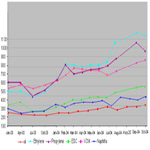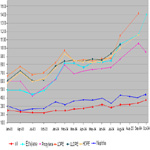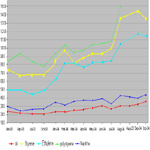|
Spiraling polymer prices are causing great concerns to plastics
processors as well user and allied industries, and have been the
hot topic of discussions over the last few months. Escalating oil
prices have been blamed for the rise in feedstock prices, which
in turn have led to rising polymer prices, currently lingering at
record peak levels. When will the rise in oil prices and subsequently
feedstock prices be arrested? When will polymer prices stabilise
and at what levels? Will the worldwide economies after a sluggish
2002-2003, face obstacles in the path to recovery? Will polymer
demand be affected by high prices? These are few of the questions
raised by our readers. In this feature, we attempt to answer many
of them thus:
 |
When did polymer prices start rising? |
 |
Global Oil Scenario |
 |
Factors affecting Polymer prices
The basic prices of oil, ethane, propane, gas
and naphtha
Capacity utilization
Demand-supply balance
|
 |
When will polymer prices stabilize? |
 When did polymer prices start rising?
When did polymer prices start rising?
As per industry, rising oil prices lead to a rise in feedstock prices,
creating a mothball effect on polymer prices. Hence, oil price hikes
should preceed polymer price hikes.
As represented in the following graphs, oil prices remained fairly
stable over a long period from January 2003 until April 2004. However,
feedstock prices started rising, particularly in Q1-2004; increasing
by 10% or more. This increase in polymer prices could be ascribed
mainly to overall increase in their demand.
In a reversal of trend, while oil prices rose by 10% in Q2-2004,
polymer price hikes did not match the pace and slowed down.
Interestingly polymer price increase
continued during Q2-2004, albeit somewhat slowly, despite an increase
in oil prices by 10% in the same period. Prices of all polymers
went up significantly from the beginning of Q3-2004.
Very minimum correlation between the increase in the price of oil,
naphtha and other feedstock and the increase in the prices of polymers
can be seen in this period.
Let us look at the increase in the prices of oil, feedstocks and
polymers and ascertain whether an increase in oil prices has resulted
in the increase in prices of the basic feedstocks or is booming
demand leading to an increase in polymer prices?
 Movement of Oil, Naphtha, EDC, VCM, Ethylene, Propylene from Jan
03-Oct 04
Movement of Oil, Naphtha, EDC, VCM, Ethylene, Propylene from Jan
03-Oct 04
 Movement of Oil, Naphtha, Ethylene, Propylene, Polyethylenes from
Jan 03-Oct 04
Movement of Oil, Naphtha, Ethylene, Propylene, Polyethylenes from
Jan 03-Oct 04
 Movement of Oil, Naphtha, Propylene, Ethylene, Polypropylene from
Jan 03-Oct 04
Movement of Oil, Naphtha, Propylene, Ethylene, Polypropylene from
Jan 03-Oct 04
 Movement of Oil, Naphtha, Ethylene, Styrene, Polystyrene from Jan
03-Oct 04
Movement of Oil, Naphtha, Ethylene, Styrene, Polystyrene from Jan
03-Oct 04
 Global Oil Scenario
Global Oil Scenario
Oil prices remained stable around US$32/barrel in early 2004, but
shot up beyond US$45/barrel around mid August and peaked at approx
US$50 end of September. Interestingly the gap between Middle East
price and Brent has widened to almost US$ 8-10/barrel indicating
speculative trading. (While Brent price is at US$50/barrel, Dubai
price is only around US$41/barrel). The flaring of oil price despite
an increase in the oil production by OPEC countries seems unjustified.
However, the global demand of oil, and that too from Asia and USA
has increased significantly. China alone has imported 40% more oil
this year so far. If the increase in the oil price continues for
a longer period, it could fuel inflation in 2005, adversely impacting
economy all around. However, IMF and World Bank still opine that
oil prices would remain on the higher side, yet would not dampen
the overall demand. The turbulence in oil prices during the last
3 months has been caused by some of the following factors:
 |
Increase in energy demand |
 |
Disruption in supply from Iraq, Nigeria, Russia and Venezuela |
 |
Limited possibility of an increased supply from the OPEC region |
To read in detail, click here : Why
are oil prices rising?
 Polymer prices depend upon
Polymer prices depend upon
 |
The basic prices of oil, ethane, propane, gas and naphtha. |
 |
Capacity utilization |
 |
Demand-supply balance |
The basic prices of oil, ethane, propane, gas and naphtha :
Global feedstock share for Ethylene production is Naphtha (53%),
Ethane (30%) and other feedstocks like propane, butane, gas oil
(17%). In the Asia Pacific region almost 80% of the Ethylene capacity
is based on Naphtha; whereas, in the Middle East almost 70% ethylene
capacity is based on Ethane. The cost of producing ethylene from
ethane in the USA is 3-4 times more than in the Middle East, but
the difference in the cost between the 2 regions for producing ethylene
from naphtha is hardly around 25%.
The petrochem plants depending on ethane, propane, gas and naphtha
as feedstock and subsequently ethylene and propylene face obstacles
in the form of a supply crunch as well as prevalent high prices.
However, very minimum correlation between the increase in the price
of oil, naphtha and other feedstock and the increase in the prices
of polymers can be seen in this period. Maximum price increase is
seen in Polystyrene and the least in PVC, possibly since Polystyrene
has to depend upon Ethylene and Benzene - both derived from oil,
while PVC depends only partly for feedstock inputs from oil.
Capacity utilization
The petrochemicals cycle peaks every 7 years. This is largely due
to the fact that as product prices increase, the manufacturers go
ahead with capacity addition. Once the capacity becomes operational
and supply outstrips demand, producers feel the pressure on margins
as competition does not allow increase in prices. As a result, prices
decline and this continues until there is further recovery in economic
performance. However, at the time of this petrochem peak, there
has been no such significant capacity expansion resulting in a tight
supply situation. The pressure of growing demand has aided in increasing
capacity utilization of polymer plants during the last couple of
years, expected to come down only when more capacity will start
going onstream towards end of 2005. Almost 13 million tons of only
Polyethylene capacity is expected to be installed and on stream
globally between 2005 and 2008, of which over 70% will be in the
Middle East and Asia-Pacific region.
Demand Supply Balance
Meanwhile, global economies are recovering all over, showing signs
of a positive change since the last two quarters of 2003. To read
GDP growth forecasts amid soaring oil prices
click here
Growing economies will definitely exert pressures
on the overall demand for polymers, directly or indirectly since
plastics are the major input/raw material for major growth drivers
of the economy: sectors such as housing and construction,
FMCG, packaging, automotive, etc. As for the domestic markets, infrastructure projects such
as telecom, road development and construction coupled with government
policies favouring agriculture and rural construction has buoyed
the markets for petrochemicals. The demand for polymers has seen
an increase of about 4% in 2003. The global economy seems to be
heating up, putting pressure on polymer demand. However, supply
side will gear up only in 2006, leading to a situation of demand-supply
imbalance expected to ease only when more capacity will go on stream.
Estimates of demand-supply indicate that pressures on supply may
ease after 2006.
 When will polymer prices stabilize?
When will polymer prices stabilize?
The impact of higher capacity will only be felt after 2006.
Until then polymer prices are expected to remain higher because
the overall demand of polymers is expected to be higher on account
of an overall improved economy. The global economy is expected to
show a healthy growth of about 4-5% in 2004 and most likely in 2005.
The fear of terrorism is likely to be seized after the US Presidential
election. Oil supply is expected to be more stable in 2005. It would
therefore not be surprising if oil prices get stabilized at lower
range of US$35-40/barrel. This will eventually have a positive impact
on the prices of polymers. Further, in the global scenario, factors
such as rising interest rates and slowing down in the Chinese demand
could possibly affect the uptrend.
Most pundits believe that the polymer prices will reduce at least
by 15% from the existing level by early 2005. Polymer demand will
be buoyant at least until 2006 when newer capacity will be commissioned.
The plastic processors need not panic due to higher prices of raw
material because the future holds bright for them at least until 2006.
|